Sea Level & Major Geological Event After Noah's Flood

Question: Noah's Ark came to rest on a peak of the "mountains of Ararat." This is a mountain range situated between the Black and Caspian Seas in southern Armenia. The Bible does not say that the Ark came to rest atop Mount Ararat in Turkey. More likely, as indicated by the travel direction of the people who migrated into the place called Babel (see: Genesis 11:2), the Ark came to rest on a mountain top farther to the east near the present-day northern Iraq/Iran region. That fact could also explain the flood legend in the fabled Epic of Gilgamesh that predates the writing of the books of Moses. But how did humans and animals quickly migrate to the other continents like Australia and North America, which are presently separated by the seas?
To begin to answer this important question we must examine another lesser-known, but important event that occurred on the Earth about one hundred years after Noah's flood:
"And unto Eber were born two sons: the name of one [was] Peleg; for in his days was the earth divided; and his brother's name [was] Joktan."
(Genesis 10:25 KJV)"And unto Eber were born two sons: the name of the one [was] Peleg; because in his days the earth was divided: and his brother's name [was] Joktan."
(1 Chronicles 1:19 KJV)
In the Hebrew language the name "Peleg" means a dividing by a "small channel of water" and is also root associated with the meaning of an earthquake. The Hebrew word translated as "divided" in the passage means to "split" something. According to the Bible genealogy, this man named Peleg was born 101 years after the flood. No doubt this Peleg was so named because of an event of great significance to the people living at the time he was born. The fact that this dividing event is mentioned by the Holy Spirit in TWO places in the Scriptures, and that the EXACT number of years between this event and the flood is also recorded, alludes to the importance of these passages in the interpretation of post-flood history.
Some Creationists have interpreted this event to be the division of the North and South American continents from the European and African continents by the Atlantic Ocean after the flood. But a division of such magnitude at that point in geologic time would invalidate our previously proposed flood model. It would also invalidate accepted paleomagnetic data which supports gradual sea floor spreading at the mid-Atlantic ridge. Besides, the Atlantic Ocean is no "small channel of water" between land masses. Obviously, that is not the answer we are looking for.
After examining the Hebrew meanings, a more plausible alternative interpretation would be that it describes an earth-splitting event such as a valley opening in the ground and filling with water. That could have happened anywhere along the Dead Sea Rift zone (discussed in detail later) and may have been associated with a delayed adjustment of the Earth's plates in response to the rapid subsidence of the sea floors by the flood.
In theory, when the weight of the waters of the flood forced the sea floors downward to fill the void left in the magma chambers beneath, strain would have developed between the oceanic and continental portions of the crustal plates. Consequently, tectonic pressures were redistributed. About 100 years later the strain and pressure redistribution may have caused the Earth's crust to rapidly rent in weaker places, much like a piece of ridged plastic which can be stretched and deformed. It will eventually snap if the strain remains constant. An abrupt further change in sea levels could possibly accompany such an event.
Looking at world relief and tectonic maps, one possible location of the effects of this Peleg event is found in Middle East. It is called the Afar Triangle.
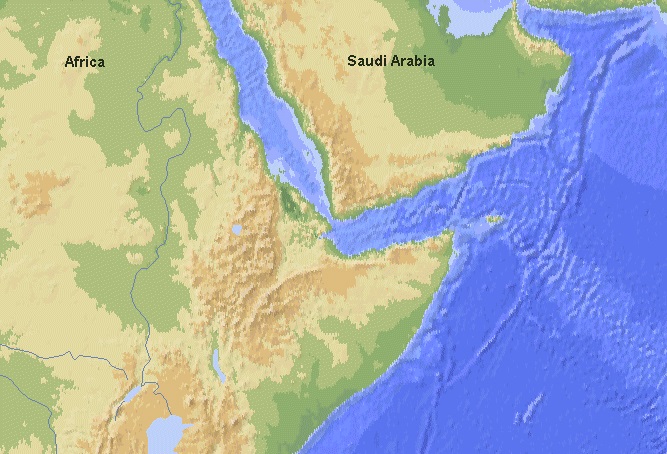
If you will examine the relief map (above), you can see where there was a geologically recent rent of Saudi Arabia from Africa. This is a fracture in the continental crust and is different from deep ocean divergence zones. If you will look closely, you can see where a mountain range was sheared and dragged apart.
The Afar fracture is a three-way split, which some geologists believe is caused by an upwelling magma plume, for lack of a better engine. The area on the African continent running south-west from that fracture locus is the Great African Rift Valley which runs down into the middle of the African continent. The area going north runs along the bottom of the Red Sea, up into the Dead Sea Rift area of Israel, up the Jordon river valley, and continues northward. This Peleg event is most likely a local reference to a widening of that Rift somewhere near or north of Israel.
The next image is a view of the Afar Triangle's tectonic features. In all likelihood, this Rift system was already active before Noah's flood, but Noah's flood triggered renewed activity. I state that because the path of the Rift from Israel continues to run south for the entire length of Ethiopia. It seems to match the described path of the river Gihon, one of four that flowed from the Garden of Eden.
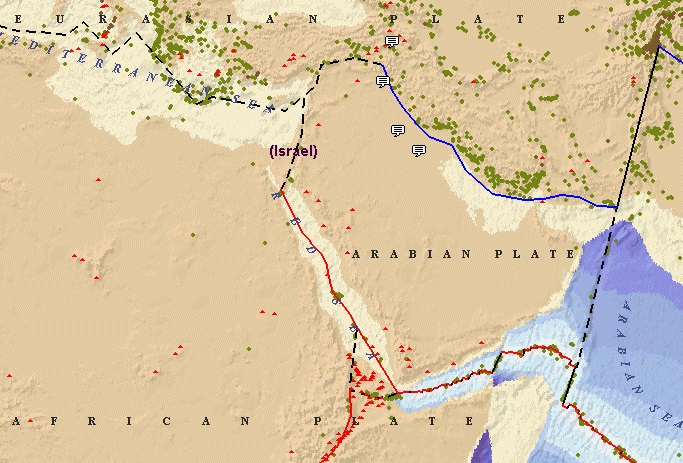
"And the name of the second river is Gihon: the same is it that compasseth the whole land of Ethiopia."
(Genesis 2:13 KJV)
If that is true, then there has been considerable tectonic activity since the Garden of Eden, and Noah's flood may have been just a contributing driver of latter changes.
Now, as for how man and animals got to places like Australia and the Americas, it is possible that they migrated there on dry land during the 101-year interval between the flood and the subsequent plate settling. Possibly, sea levels may have risen quite a bit since the post-flood migrations began, and even more after the Days of Peleg. An examination of the geology of the region between Indochina and Australia shows that the sea between the two continental masses is relatively shallow.
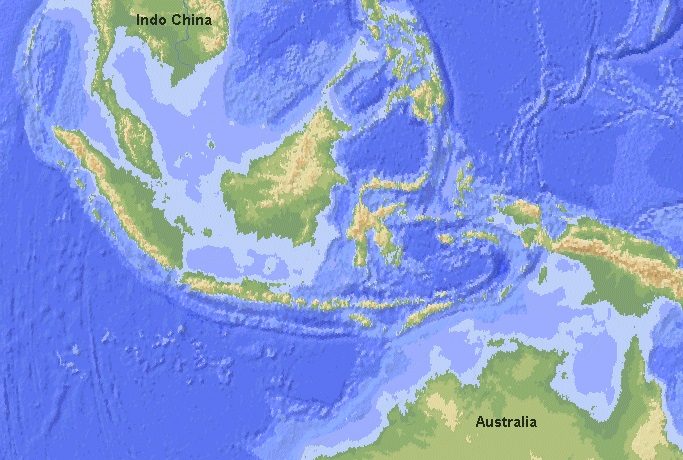
The same is true of the Bearing Straits separating Alaska from Russia, where the waters are only about 50 feet deep between the tip of Asia and North America. It is theoretically possible that in the 101 years following the flood, and before the events of Peleg's days, narrow land bridges (which today are submerged) may have still existed between many places across the globe. The fact that the ruins of many ancient cities in the Mediterranean Sea area, which postdate the time of Noah's flood and are found underwater today, tells us that global sea levels have increased by several meters since those cities were built, or there has been wide-spread subsidence since then. Regardless, an appeal to present-day sea levels is not a valid argument against post-flood migrations to regions now inaccessible across dry land.
Assuming that some land bridges existed briefly after the flood by whatever mechanism, the question is: Did man and beast have sufficient time to migrate from the resting place of the Ark to other continents before the dividing? Well, let's do the math:
If you calculate the distance from eastern Mesopotamia to the tip of Australia and divide it by 100 years, you will find that both man and beast would only have to migrate less than 80 miles a year (0.21 miles a day) in order to reach Australia; less than 55 miles a year (0.15 miles a day) to reach North America via the Bearing Straits; and less than 48 miles a year (0.13 miles a day) if a land bridge (or possibly an ice bridge) existed across the northern polar regions. Those average daily distance requirements are much less than most people walk each day in their normal routines. The data support the Scriptures.
"These [are] the three sons of Noah: and of them was the whole earth overspread."
(Genesis 9:19 KJV)
Shortly after the Ark landed on the mountains of Ararat, the families of mankind spread across the world. At that point in time mankind all spoke a common language and the bulk of them appear to have migrated westward, although it is safe to assume that some settled near the place where the Ark came to rest, and the oral tradition of Gilgamesh and the flood probably originated with the latter. Those people who did migrate westward are spoken of in Genesis 11:1-2:
"And the whole earth was of one language, and of one speech. And it came to pass, as they journeyed from the east, that they found a plain in the land of Shinar; and they dwelt there."
(Genesis 11:1-2 KJV)
That land of Shinar is Babel (Babylon), and there the Bible says the Lord confounded their language and from there they scattered out across the face of the Earth.
Linguistic researchers have put forth the results of studies which tend to indicate that all the Indo-European languages originated in ancient Turkey. Although the given time frame of this occurrence is off by a few thousand years (and is probably conjecture), it is very interesting to see that otherwise it is in close agreement to where the Bible tells us what happened at Babel in the post-flood world.
Other Evidence of Geologically Recent Sea Level Changes
The geology of the Earth's oceans shows evidence of major, and in some cases, rapid fluctuation in sea level across recent geologic history. Such evidence can be found in areas near the continental margins. In the Atlantic Ocean, just off the New England coast, there is an underwater mountain chain that is evidence of this.
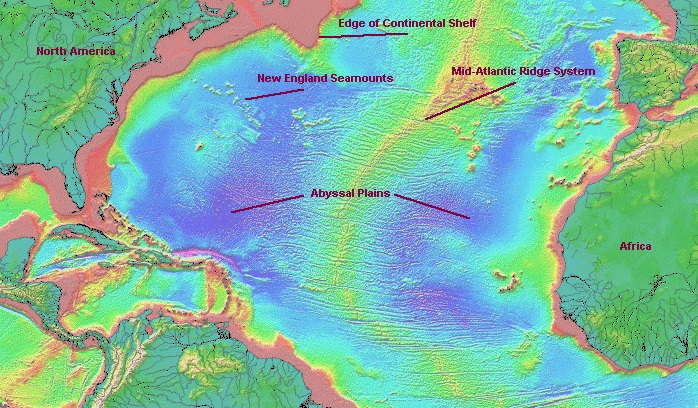
The New England Seamount chain stretches about 1,600 miles southeast of New England. This chain has more than 30 major peaks, all a kilometer (3,281 feet) or more below the surface. There is evidence to confirm that the tops of these seamounts were once at or above the surface of the ocean in the relatively recent past. Deep-sea dredging of some of these seamounts brought up Eocene (37-58 mya) limestone, which is of shallow water origin. In a subsequent visit to the seamount in the research submarine Alvin, there was the first eyewitness observation reported of dead coral. (Coral only grows near the surface.) Rock samples were also collected which contained bits of dead algae (which only grows within 100 meters of the surface). The conclusion is that these seamounts have either subsided on the order of one kilometer since the Eocene, or that sea level has changed drastically since the Eocene.
Research references: J.R. Heirtzler, et al, "A Visit to the New England Seamounts" American Scientist 65 (1977). Wolfgang Schlager "The Paradox of Drowned Reefs and Carbonate Platforms" Bulletin of the Geological Society of America 92 (1981). Harold L. Levin "Contemporary Physical Geology", Crustal Deformation and Global Tectonics, page 290, figures 9-38 & 9-39, (1981)
This conclusion, however, presents a logical problem to mainline science, as coral reefs grow at known rates that would easily stay ahead of geological subsidence of the seamount. They would stay ahead of sea floor spreading by continental drift, and they would stay ahead of gradual elevations in sea level, as assumed under Uniformitarism Earth Science paradigms. The New England Seamounts are not unique. Similar recorded occurrences of finding shallow water sediments, reefs, and carbonate platforms in deep water regions have been recorded in many other places in the Earth's oceans, so the New England Seamounts are not an isolated anomaly. Since gradual processes are inadequate to explain the New England Seamount observations, or observations elsewhere, the alternative conclusion is that either the sea floor sank catastrophically, or that extraordinary volumes of water were added catastrophically, or both.
A combination of sea floor downward warping AND increased sea level resulting in deeper ocean basins following Noah's flood would appear a plausible explanation for finding shallow water sediments in deep water regions today. Is there other undersea evidence to support this theory? Yes! It should be noted that the tops of the submerged New England Seamounts are at the same approximate depth as the edge of the Continental shelf, which is also at a depth of about 1000 meters worldwide.
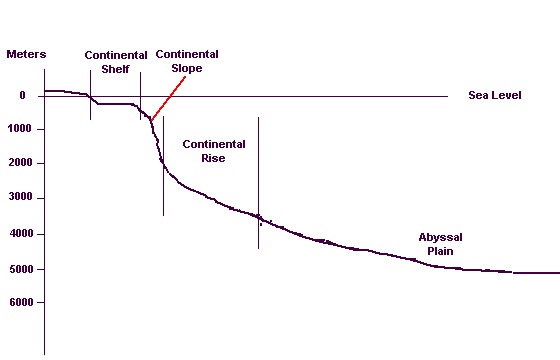
This edge is called the Continental Slope, a zone where the sea floor plunges sharply downward to the Continental Rise and the even deeper abyssal plains. This slope's contour, worldwide, delineates the actual edges of the continents.
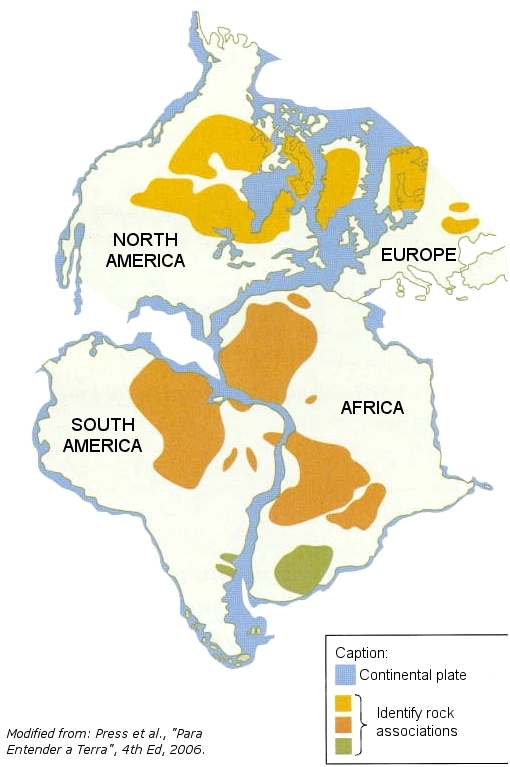
All of the world's continents have their closest "fit" at the present 1000-meter sea level depth if you put then back together like a giant jigsaw puzzle. Although the thicker and relatively lighter granitic continents have drifted apart over time, they essentially have retained the same general shape in respect to their contact with the thinner and heavier basaltic oceanic basins.
Along the outer edges of the relatively flat Continental Shelf, near the Continental Slope zone, are numerous underwater "canyons" which cut downward sharply into the floor of the shelf. These canyons are similar to ones cut by fast-flowing waters eroding away rock as observed on land when the flow gradient is very steep. For example, in a portion of a river that drops 800 feet in five miles, the water speed and erosion power is much greater than a portion of river that only drops eight feet in five miles.
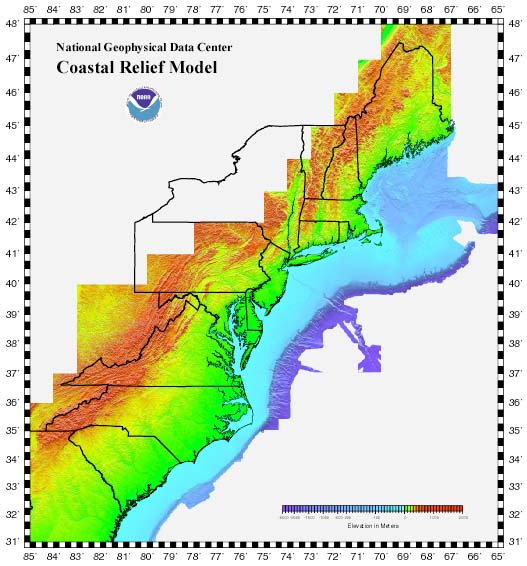
Over 80% of the canyons on the edge of the Continental Shelf can be directly traced back across the relatively flat plain of the Continental Shelf, following now submerged river beds to the mouths of rivers that exist today. This reveals that most of the underwater canyons are clearly extensions of those same present-day rivers, and those canyons were likely cut when the continents stood higher above sea level. In the NOAA graphic above you can see these canyons on the edge of dark blue area.
If the Earth's ocean level was 1000 meters lower before Noah's flood, the canyons are easily explained by the force of the river waters running off the flat land of the present Continental Shelf (which would have been above sea level at that time) and down the relatively steep edges of the continental slope. The rivers would have eroded deep channels in the rock, at the edge of the shelf, as they plunged sharply downward to the antediluvian sea level. High-velocity turbidity currents carrying silt and rock particles could further erode the canyons in post-flood times after they were submerged below today's prevailing sea level.
The existence of the submerged river beds across the shelf indicate that at some time in the past, the Continental Shelf was above sea level, and rivers flowed gently across those coastal plains until they reached the edge area. Near the edge zone the gently flowing rivers turned into cascading rapids and falls, the accelerated flow and sediment load further eroding the deep canyons.
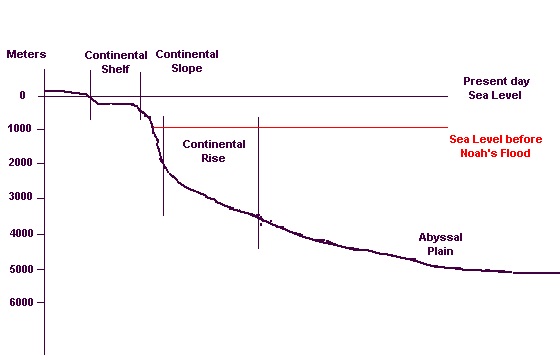
Combining the drowned reefs of the New England Seamounts and the submerged river beds of the Continental Shelf, we have observable physical evidence that supports the flood model. The data suggest both that the floors of the great ocean basins sank to greater depths and that sea level is about 1000 meters higher today than it was before the flood.
In the next chapter we will discuss why the Earth's sedimentary deposits were made well before Noah's flood and are not, as Young Earth Creationists claim, proof of Noah's flood.
Disclaimer: External Links
from this website are for instructional or promotional purposes and do not
constitute an endorsement
by the The Bible, Genesis & Geology Ministry.
All original text © 1997 -
2021
Gaines R.
Johnson, D.D., D.Th.
The Bible, Genesis & Geology Ministry
Materials from this site may
be freely copied to paper for personal use or church Bible studies.
They may not be reproduced
elsewhere on the Internet, for either personal or commercial use, without
the express written permission of this Ministry.
Are you saved? Are you Sure? Click the image below for the Gospel Truth about the Lord Jesus Christ in your native language!


